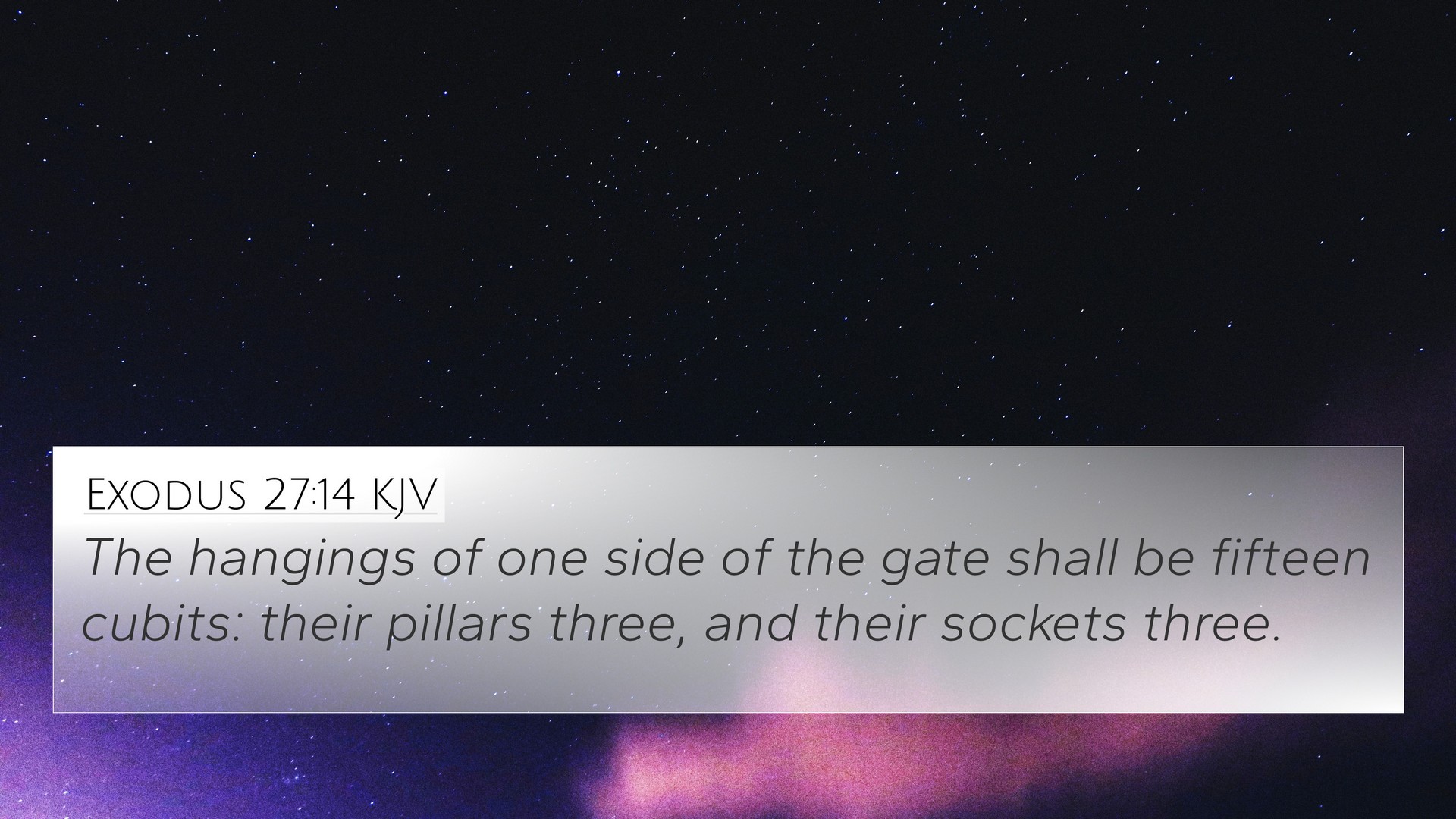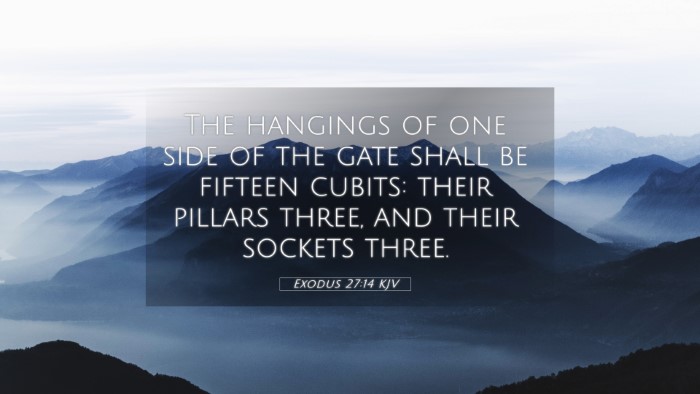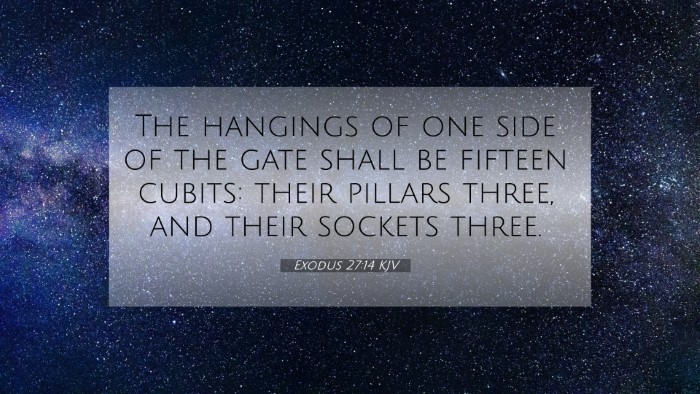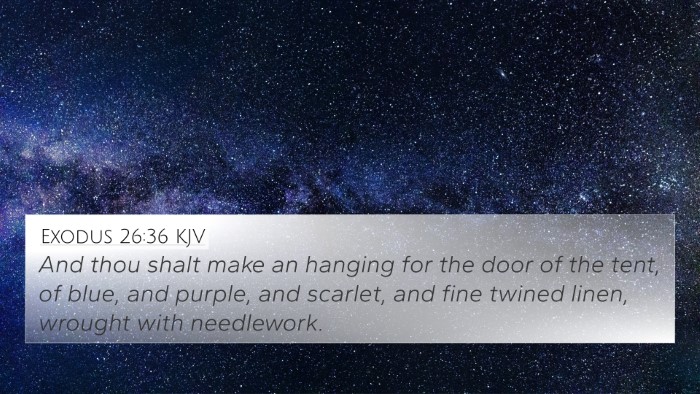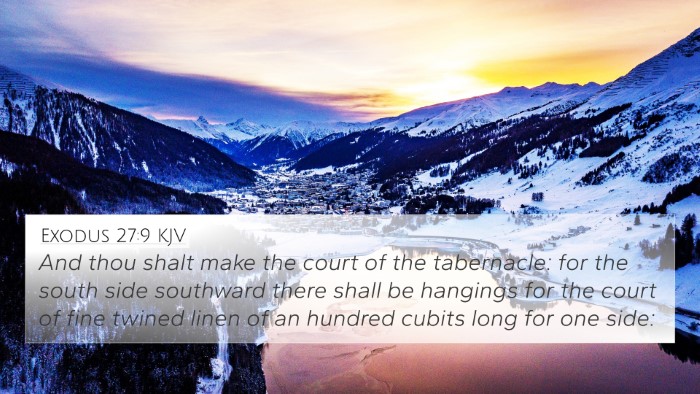Understanding Exodus 27:14
Exodus 27:14 states: “The hangings of one side of the gate shall be fifteen cubits; their pillars shall be three, and their sockets shall be three.” This verse is part of God’s detailed instructions regarding the construction of the tabernacle's outer court, outlining the dimensions and components of the entrance gate.
Interpretation and Summary
The instructions found in this verse are set in a larger context of the regulations concerning the tabernacle. The gate signifies accessibility and the boundary between the holy and the common. It serves not only a functional purpose but also a spiritual one, emphasizing the importance of entering God’s presence through designated means.
Insights from Public Domain Commentaries
The following insights combine the readings from notable commentaries:
- Matthew Henry: He emphasizes the significance of the gate as a representation of Christ, who is the way to God. The prescribed dimensions may symbolize the idea that access to God is available but measured and requires reverence.
- Albert Barnes: Barnes points out the meticulous nature of God’s instructions, which reflects His desire for order and holiness in worship. The specific measurements ensure that the tabernacle would be built exactly as intended, enhancing its function and significance.
- Adam Clarke: Clarke elaborates on the materials used for the hangings and pillars. He interprets these elements as symbolic of strength and communication with the divine. Clarke also highlights the centrality of this gate in the worship ritual, making it a focal point of the access to the tabernacle.
Symbolism and Thematic Connections
The gate, as described in Exodus 27:14, opens avenues for numerous theological representations:
- Accessibility to God: The gate symbolizes the means by which believers can approach God. Just as entrance to the tabernacle is regulated, access to God today is through Jesus Christ (John 14:6).
- Divine Order: The specific dimensions illustrate God's attention to detail and His sovereignty over worship practices, reminding believers of the importance of following divine guidelines.
- Spiritual Opposition: The design illustrates a boundary, highlighting the separation between the sacred and profane—a theme prevalent throughout Scripture.
Cross-References
Several Bible verses also illuminate themes related to Exodus 27:14. Notable cross-references include:
- John 10:9: "I am the door; if anyone enters by Me, he will be saved." This connects the idea of Jesus as the ultimate access point to salvation.
- Hebrews 9:2: Discusses the structure of the earthly sanctuary, paralleling the tabernacle's design.
- Matthew 5:23-24: Emphasizes reconciliation before approaching God in worship, reflecting the importance of holy access.
- Revelation 21:12: The New Jerusalem's gates represent eternal access to God’s presence.
- 1 Timothy 2:5: "For there is one God and one Mediator between God and men, the Man Christ Jesus.” Relates to the mediation necessary for worship.
- Exodus 26:36: Similar discussion about the hangings used in the tabernacle, linking back to the consistent worship structure.
- 1 Corinthians 1:20-24: Discusses Christ as folly to the Gentiles but wisdom to those who believe, reaffirming the need for proper access to divine truth.
- Hebrews 10:19-20: "Therefore, brethren, having boldness to enter the Holiest by the blood of Jesus, by a new and living way..." connecting Old Testament access imagery with New Testament fulfillment.
- Psalm 100:4: "Enter His gates with thanksgiving, and His courts with praise." Emphasizing worship as access to God's presence.
- John 1:51: "You will see heaven opened, and the angels of God ascending and descending upon the Son of Man." Manifesting the connection between divine access and Jesus.
Conclusion
Understanding Exodus 27:14 yields profound insights into the nature of worship and access to God. This verse underscores the importance of reverence in approaching the sacred, pointing forward to the fulfillment found in Christ. Exploring the cross-references reveals thematic connections that enrich our understanding of the biblical narrative and deepen our relationship with God.
Further Study Suggestions
For those looking to delve deeper into cross-referencing and thematic connections within the Bible, consider using tools such as:
- Bible concordances, which can help identify related verses.
- Bible cross-reference guides to navigate intertextual connections.
- Comprehensive Bible reference resources for a fuller understanding of scriptural themes.
- Methods for cross-referencing Bible texts in personal study or sermon preparation.
